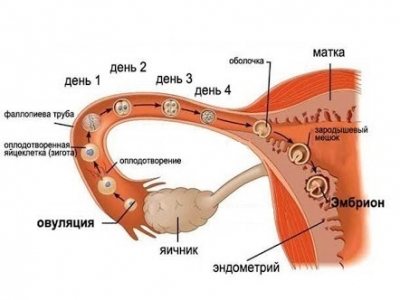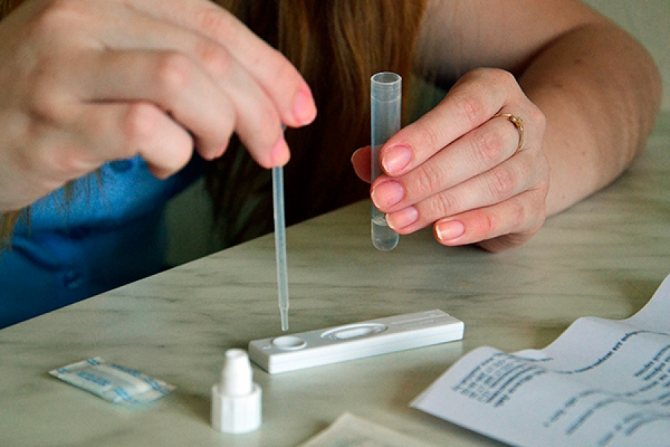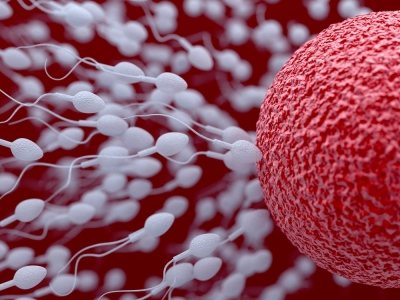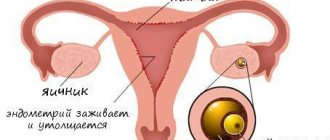14.03.2017 0
1871
Has anyone thought about how things could turn out if we had the opportunity to find out in advance about fertilization, and, accordingly, about the onset of pregnancy? But this process is often difficult to predict and sometimes it is quite difficult to understand on which days you should use contraceptives (especially hormonal ones), and on which days, on the contrary, you should refrain from using protection during sexual intercourse. Next, we will try to figure out what day after intercourse conception occurs and when a pregnancy test can show this.
Fertilization process
Pregnancy occurs as a result of conception, i.e. fertilization of an egg by a sperm. To increase the likelihood of pregnancy, sexual intercourse should occur a few days before ovulation or in the first 12-24 hours after it. This is due to the short time frame of egg viability.
In the fallopian tube, sperm meet the female reproductive cell. To get inside, tadpoles must overcome the primary shell of the egg, called the corona radiata. It consists of follicular cells that are glued together with hyaluronic acid.
To liquefy this membrane, a large number of tadpoles use hyaluronidase; one sperm cannot cope with this task. After the radiant crown dissipates, the “luckiest” living creature, having overcome the next shiny shell, finds itself inside . At this point, the egg becomes fertilized and inaccessible to other male reproductive cells.
INTERESTING! During the process of conception, the sperm most often loses its tail.

zygote .
It begins to develop already at the stage of travel towards the uterus. This journey lasts about 4–5 days. After 20–21 hours, the union of male and female genetic material occurs. Approximately 30 hours after the fertilization process, the zygote begins its first division . This process is called crushing. Cells that arise as a result of cleavage are called blastomeres . First 2 cells are formed, then 4.
On the third day, the number of blastomeres reaches 8. On the 4th day after conception, 16 cells appear and the embryo is called a morula. The cleavage process continues, but as soon as fluid appears inside the morula, the embryo forms into a blastocyst . This is the last stage of embryo development before implantation.
When the fertilized egg reaches the uterus and goes through all stages of division, it begins to penetrate its walls. Depending on the place of attachment, the location of the baby in the stomach depends. There is an opinion that implantation along the posterior wall is characterized by a deeper seating of the fetus and, as a result, a small belly of the woman. The attachment along the anterior wall is distinguished by the large size of the abdomen.
The process of implantation of the embryo into the uterus takes several days. During this period, a woman may feel:
- deterioration of condition;
- increased body temperature;
- headache;
- nausea.
A specific sign of implantation is the occurrence of bleeding . They appear as a result of damage to the walls of the uterus.
When to get tested after an unprotected act
How long after sex you can get tested for infections can be found out by visiting a doctor.
Signs of infection with many infections do not begin to appear immediately, but only after an incubation period, during which the pathogenic flora actively multiplies in the body.
At this time, there are still no symptoms, but by the appearance of the mucous membrane and the nature of the discharge, an experienced specialist can already guess what kind of infection we are talking about.
Modern diagnostics make it possible to detect possible infection at an early stage of the disease.
But most infections may not be detected during the incubation period.
Therefore, you should not rush into the examination and immediately get tested after an unprotected act.
How do you know when after unprotected sex you can take blood tests for chlamydia, mycoplasma, ureaplasma and other infections?
It is necessary to know the duration of the incubation period of the diseases they cause.
The incubation period for the most common sexually transmitted infections is approximately:
- for gonorrhea - at least 2-5 days
- if gonorrhea is accompanied by trichomoniasis, the incubation time increases to 10 days
- for syphilis, hepatitis and HIV infection - from 2 weeks and can last up to 6 months
- for chlamydia – from 2 weeks to 2 months
- for mycoplasma, ureaplasma and trichomonas infections - up to 2 weeks
The duration of the incubation period depends on many factors: the state of the immune system, the general condition of the body, lifestyle, etc.

The higher the body’s ability to fight pathogenic flora, the longer the IP will be.
You can undergo a comprehensive diagnosis after sexual contact with an unverified partner in a couple of weeks.
At this stage, signs of infection may already appear in the biomaterial.
Is it possible to bring a partner for STI testing?
The doctor’s answer will be positive, since in order to avoid possible infection, it is better for both partners to get tested.
Such measures will help prevent further relapse.
The timing of donating blood for syphilis, HIV infection, and hepatitis depends on the method of diagnosing the disease.
The most informative types of research are:
- Bacterioscopy is an examination of a smear under a microscope. The method allows you to detect the presence of an inflammatory process, as well as pathogenic flora: gonococci, fungal flora and bacterial infection. Results are ready in a few hours or the next day.
- Bacteriological culture is a longer-term diagnostic method and ranges from two days to two weeks. The biomaterial taken from the patient is placed on a nutrient medium. As pathogenic bacteria grow, they form colonies. Thus, the laboratory assistant can accurately determine the type of pathogen and its relationship to antibiotics. Based on the analysis data, the doctor will be able to select a drug that is effective against this pathogen.
- ELISA (enzyme-linked immunosorbent assay) . Blood is examined. The presence of antibodies to the pathogen allows us to conclude that it is involved in infecting the body. It will take a laboratory technician one day to carry out the analysis.
- PCR diagnostics. This technique is one of the most accurate and provides complete information about the pathogen and its development in the body. Allows you to detect all types of infections. The essence of the technique is to detect pathogen DNA fragments in biomaterial. Its advantage is that even at the earliest stages of infection development it is already available for detection. The material for research is biological fluids of the body. The period for obtaining results is no more than 4-5 hours.

The PCR method will help in the diagnosis of latent infections (mycoplasmosis, ureaplasmosis, chlamydia), diseases of viral and fungal origin.
To obtain reliable research results, proper preparation for taking biomaterial is important.
Time frame
The egg is considered fertilized from the moment the sperm penetrates inside. But at what minute ovulation will occur or, if sexual intimacy occurred after the rupture of the follicle , then how long it will take for the male tadpoles to reach the egg is very difficult to predict. That is why no one can determine time accurately to the minute.
REFERENCE! The egg is viable for 12-24 hours, so the time available for conception is limited to this period.
It is possible to establish only an approximate time period during which conception is more likely to occur. But for this it is necessary to determine the exact day of ovulation. The following methods will help:

- The most accurate is folliculometry . This procedure is performed dynamically throughout the cycle using ultrasound.
- A special test to determine ovulation.
- Measuring basal temperature.
- Analysis of cervical fluid.
- Position of the cervix.
After the follicle ruptures, the female reproductive cell enters the abdominal cavity and is almost immediately “sucked” into the funnel of the fallopian tube. If sperm are already inside, then fertilization occurs within a few hours after ovulation.
ON A NOTE! After ejaculation, the living creatures move quickly. Within 1–2 hours they can end up in the fallopian tubes, where fusion with the egg occurs. If ovulation has not yet occurred, then sperm are waiting in the wings. They can remain fertile for 5–7 days.
Rapid tests for infections after unprotected intercourse
Can you use tests sold at pharmacies to determine if you have an STI?
The pharmacy chain sells test strips that are used for express analysis when you urgently need to obtain information about infection.
Read also PCR for hepatitis C

They can answer the question: whether infection has occurred, but do not provide full information about the disease.
Therefore, you should not exclude visiting a doctor.
When does pregnancy occur?
Pregnancy begins from the moment of conception, but it will be considered full only after the embryo has successfully passed all stages of division and is securely attached to the uterine mucosa. Implantation, as a rule, begins 6–7 days after fertilization and lasts about 3 days.
After implantation, the embryo begins to produce the hormone hCG ; it can be detected in the blood earlier than in the urine. Therefore, experts recommend carrying out pregnancy tests only after 14 days from the moment of conception.
REFERENCE! According to statistics, about 80% of all conceptions do not result in full-fledged pregnancies.

- Good sperm count.
- Patency of the fallopian tubes.
- Sufficient thickness of the endometrium.
- Completeness of genetic material.
Many women begin to guess about their situation even before it becomes obvious. They experience changes in appetite and taste preferences . Apathy and drowsiness appear. Sometimes these signs can be confused with symptoms of premenstrual syndrome.
In certain situations, uterine tone may occur. It is characterized by uterine contractions that make the woman uncomfortable. Some women experience a feeling of “fullness” in their abdomen. Pregnancy can also be felt on an intuitive level.
ON A NOTE! To confirm an interesting situation before the delay occurs, you can donate blood to determine the hCG hormone. Its increase will indicate successful conception.
Analysis methods
PCR diagnostics, tank cultures and flora smears are among those types of studies that are fundamental in making a diagnosis.
- To carry out PCR diagnostics, you will need to take a smear. This is the most accurate method of testing for STIs. The test result may be positive or negative. If it is positive, this means that there is a pathological microflora in the body. In this case, treatment should be started immediately.
- The flora research technique is basic, since the analysis allows you to diagnose the inflammatory process, if present. Under a microscope, a laboratory technician can detect cells and pathogenic flora in a smear that are atypical for a normal smear.
- A tank culture can be used to confirm the diagnosis. Having taken a smear, the laboratory technician places it on a nutrient medium and then in a thermostat. In this way, the growth of bacterial colonies is observed, after which they are identified.
Read also Smear-imprint
Some patients are interested in whether and when it is necessary to undergo diagnostics during drug prevention.
When treating the genitals with antiseptic solutions immediately after the act, the risk of developing an infection is reduced several times.
In some cases, the risk of infection is reduced to zero.











